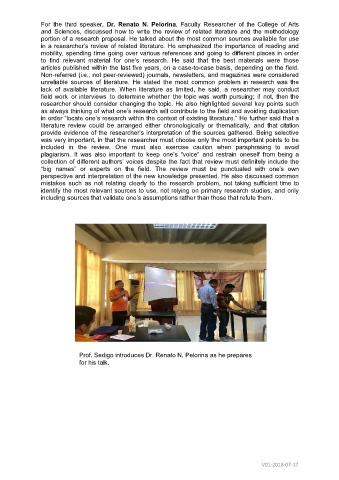Page 479 - Area_V_Parameter_C
P. 479
For the third speaker, Dr. Renato N. Pelorina, Faculty Researcher of the College of Arts
and Sciences, discussed how to write the review of related literature and the methodology
portion of a research proposal. He talked about the most common sources available for use
in a researcher’s review of related literature. He emphasized the importance of reading and
mobility, spending time going over various references and going to different places in order
to find relevant material for one’s research. He said that the best materials were those
articles published within the last five years, on a case-to-case basis, depending on the field.
Non-referred (i.e., not peer-reviewed) journals, newsletters, and magazines were considered
unreliable sources of literature. He stated the most common problem in research was the
lack of available literature. When literature as limited, he said, a researcher may conduct
field work or interviews to determine whether the topic was worth pursuing; if not, then the
researcher should consider changing the topic. He also highlighted several key points such
as always thinking of what one’s research will contribute to the field and avoiding duplication
in order ―locate one’s research within the context of existing literature.‖ He further said that a
literature review could be arranged either chronologically or thematically, and that citation
provide evidence of the researcher’s interpretation of the sources gathered. Being selective
was very important, in that the researcher must choose only the most important points to be
included in the review. One must also exercise caution when paraphrasing to avoid
plagiarism. It was also important to keep one’s ―voice‖ and restrain oneself from being a
collection of different authors’ voices despite the fact that review must definitely include the
―big names‖ or experts on the field. The review must be punctuated with one’s own
perspective and interpretation of the new knowledge presented. He also discussed common
mistakes such as not relating clearly to the research problem, not taking sufficient time to
identify the most relevant sources to use, not relying on primary research studies, and only
including sources that validate one’s assumptions rather than those that refute them.
Prof. Sedigo introduces Dr. Renato N. Pelorina as he prepares
for his talk.
V01-2018-07-17

